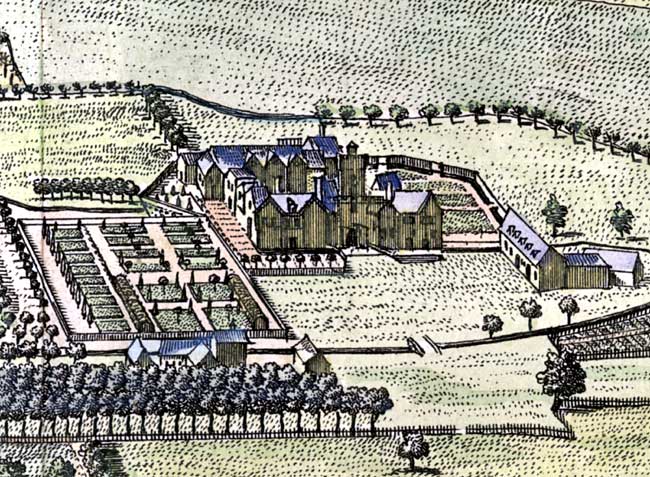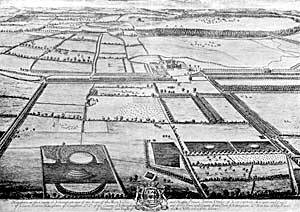Haughton Hall
By THOS. M. BLAGG, F.S.A.

View of Haughton Hall, c. 1709.
CURTIS, in his History of Nottinghamshire, writes in 1844:— "Haughton Hall, once the site of the hospitable mansion of the Holles's, Earls of Clare, is now occupied by a neat farmhouse; part of the wall of the gable and of one bay of present dwelling seems to be the only relic of this once capacious structure. The moat still remains to determine its extent, the circumference of which would enclose a baronial castle of no insignificant magnitude” . . . "Haughton Park containing about 900 acres, the greater part in the parish of Bothamsall, is now completely dis-parked, enclosed and divided into farms."
Haughton lay waste at the time of Domesday and was granted to Roger Pictavensis and with the rest of his fees became parcel of the Duchy of Lancaster. By the middle of the 14th century it had become the possession of the family of Longvilliers and remained with them for several generations, thus obtaining the name by which it was sometime known—Haughton Longvilliers. By the marriage of Elizabeth, daughter of Thomas Longvilliers with Robert Mallovel of Rampton it passed to that family, and by the marriage of her grand-daughter, Elizabeth, to John Stanhope, son of a burgess of Newcastle, to the family of Stanhope, who from that time appear to have assumed and used the arms of Longvilliers without difference. Haughton remained with the Stanhopes for seven generations, and then, of two brothers, Michael Stanhope settled at Shelford and founded the well-known noble family who became Earls of Chesterfield, while Richard Stanhope of Haughton had no son, and his daughter, Saunchia, married John Babington, and this couple sold Haughton in 1537 to Sir William Holles, whose father, another Sir William, became Lord Mayor of London two years afterwards (1539) and died 20th October, 1542. He also owned property in Notts. for he held lands at Egmanton and Dunham, which passed to his eldest son, Thomas, (I.P.M., Thor. Soc. Rec., Ser. III., 270). But Thomas dissipated his inheritance, whereas the younger brother, Sir William, became a man of vast wealth and lived here at Haughton in great splendour. "He began his Christmas at All Hallowtide and continued it until Candlemas, during which any man was permitted to stay three days without being asked whence he came or what he was." An ox was roasted whole on each of twelve successive days when Sir William kept Christmas at Haughton. He was known as "Good Sir William." He refused to marry his daughter to the Earl of Cumberland because he, a commoner, refused to have a son-in-law before whom he would be expected to stand cap in hand. He attended the coronation of King Edward VI. with fifty retainers in blue coats and badges in his retinue and be never went to the Sessions at Retford without thirty "proper fellows" at his heels. He kept his own company of actors to amuse him with plays and masques in the long winter evenings at Haughton. In the summer they toured the country as "strolling players." Good Sir William enjoyed life here at Haughton for over half a century after he bought the estate, and dying 18th January, 1590, was buried in this chapel. His grandson, John Holles, became Earl of Clare. From the Holles’s, Haughton passed by female descent to the Pelhams and then to the Clintons, Dukes of Newcastle-under-Lyme, to whom it gives the title of Viscount Haughton, and with whom it still remains. The Dukes of Newcastle in the first half of the 18th century made Welbeck their seat, and then, the Holles and Cavendish estates becoming separated again and the latter passing to the Bentincks, the Dukes of Newcastle built themselves a palace at Clumber in 1770, and Haughton was entirely destroyed.

View of Haughton Park, c. 1709.
Although owned by the Stanhopes for so long, it was not until 1509 that Haughton became a large park. Before that, the park was probably confined to the land round the house, on the north side of the rivulet and in Bothamsall parish, but in the 2nd Vol. of our Society’s Record Series, the Domesday of Enclosures, I find that evidence was given before the Commissioner at Nottingham in 1517 that Edward Stanhope on 4th October, 1509 "imparked 240 acres at Haughton by enclosing them within a paling for the purpose of rearing wild animals." This part of the park stretched southward from the river as far as and just including the Duck Decoy, which, though disused, still exists in the direction of the Walesby Road. This appears from a view of the whole park, with the house and “lay-out” as engraved and published by W. Kip in 1709. Of the house itself, Gervase Holles the antiquary, great grandson of "Good Sir William" tells us, "The house itself is an old building with little uniformity in it, as being built at different times. The oldest part of it is the tower at the entrance," and then gives the heraldry of the Stanhope’s shields which appeared on the north and south sides of the gate-house. He adds,
“It appears that the hall was built by the last Sir William Holles, as appears by this ensuing, which is carved in stone on either side the entrance doore and expresses the yeare of the lord, his name and rebus. On the right hand is a man’s hand holding a vine branch loaded with fruit, upon which is a shield inscribed thus
W.H. A°. Di. 1545.
Of the still remaining Duck Decoy, it is worthy of record that it is one of the oldest, probably far the oldest in England. Some description is given of it in the Victoria County History, in the section dealing with the sport of the county. It is there stated that the pond is eight acres in extent, in the middle of a wood of thirty acres and that it has been under the care of a family named Ward for many generations. It is dealt with in detail by Sir Ralph Payne-Gallwey in his Book of Duck Decoys.
